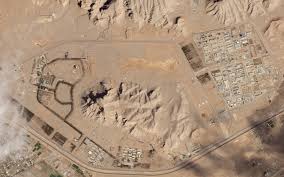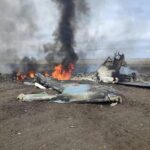For more than a decade, Israel has rehearsed, time and again, bombing and missile campaigns that would take out Iran’s nuclear production capability, much of it based around the city of Isfahan and the Natanz nuclear enrichment complex 75 miles to the north.
That is not what Prime Minister Benjamin Netanyahu’s war Cabinet chose to do in the predawn hours of Friday, and in interviews, analysts and nuclear experts said the decision was telling.

So was the silence that followed. Israel said almost nothing about the limited strike, which appeared to do little damage in Iran. U.S. officials noted that the Iranian decision to downplay the explosions in Isfahan — and the suggestions by Iranian officials that Israel may not have been responsible — was a clear effort by Iran’s Revolutionary Guard to avoid another round of escalation.
At the White House, officials asked the Pentagon, State Department, and intelligence agencies to stay quiet about the operation, hoping to ease Iran’s efforts to calm tensions in the region.
But in interviews, officials quickly added they worried that relations between Israel and Iran were now in a different place than they had been just a week ago. The taboo against direct strikes on each other’s territory was now gone. If there is another round — a conflict over Iran’s nuclear advances, or another strike by Israel on Iranian military officers — both sides might feel more free to launch directly at the other.
Netanyahu was under competing pressures: President Joe Biden was urging him to “take the win” after a largely ineffective aerial barrage launched by Iran last week, while hard-liners in Israel were urging him to strike back hard to reestablish deterrence after the first direct effort to strike Israel from Iranian territory in the 45 years since the Iranian revolution.
U.S. officials say they recognized quickly that they could not talk Netanyahu out of some kind of visible response.
So the White House and the Pentagon urged what amounted to what one senior U.S. official called a “signal, not a strike,” with minimal chance of casualties. But while it was a minimalist option, its long-term effects on the Revolutionary Guard and the teams of scientists who work on Iran’s nuclear program have the potential to be substantial. They could speed a movement to put more nuclear facilities deep underground or to expand them to make it even harder for nuclear inspectors to understand where Iran is doing its most sensitive work.
And, U.S. officials worry, that may accelerate confrontation over the nuclear program itself, which has grown more and more opaque to inspectors over the past two years.
The signal sent by the decision to hit a conventional military target in Isfahan was clear: Israel demonstrated that it could pierce Isfahan’s layers of air defenses, many of them arrayed around key sites such as the Isfahan uranium conversion facility.
That 25-year-old facility, relatively vulnerable to a strike, is Iran’s primary production line for converting its large stores of natural uranium into a gas — called UF6 — that can be fed into centrifuges to produce nuclear fuel, either for power production or nuclear weapons.
Israeli warplanes also fired missiles at Iran during the attack, suggesting that more advanced firepower was involved than initial reports had indicated.
It was not immediately clear what types of missiles were used, where they were fired from, whether Iran’s defenses intercepted any or where they landed. But just as the drones launched from under Iran’s nose sent a message about Israel’s capabilities, so did guided missiles from Israeli warplanes.
A senior U.S. official, speaking on condition of anonymity to discuss sensitive intelligence assessments, said Friday that Israel had notified the United States through multiple channels shortly before the attack. But unlike the alert Israel gave the administration moments before its warplanes struck the Iranian Embassy complex in Damascus, Syria, on April 1, the official said this latest attack was not unexpected given all the warnings Israel had issued during the week.
“While there has been no official claim of responsibility for the overnight attack against the military base in Isfahan, the message is clear: Iran’s attempt to unilaterally move the goalposts of war in the region will not be met with silence and inaction,” said Dana Stroul, the Pentagon’s former top Middle East policy official who is now at the Washington Institute for Near East Policy. “A state-on-state attack involving drones and missiles will be met with a response.”
“Yet last night’s strike was precise and limited,” Stroul added. “The message is that Iranian air defenses are entirely penetrable, and their forces cannot protect their military bases from external attack. But the damage was limited. If Iranian leaders decide that further escalation is not worth the risk of a much more lethal and expensive attack within their territory, this escalation cycle can close.”
The longer-term effects are harder to predict. Vali Nasr, an Iran expert and former dean of the Johns Hopkins School of Advanced International Studies, noted recently that Iran would likely now be determined to move its weapons “closer to Israel,” and may face new pressure at home to openly seek a nuclear deterrent.
Iran has barred some, but not all, inspectors from the International Atomic Energy Agency, the world’s nuclear watchdog. It has enriched uranium to 60% purity, putting it just days or weeks from bomb-grade quality. And at the height of the conflict with Israel last weekend, some senior commanders talked publicly about Iran reconsidering its official position, which is that it would never seek a weapon.



